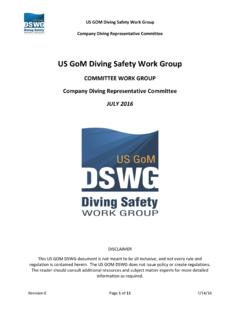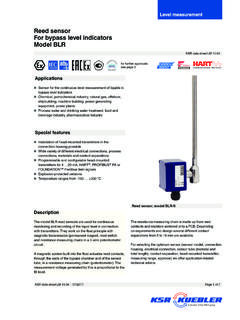Transcription of ABS Underwater Rule Requirements, Surface Supplied Diving ...
1 2015 American Bureau of rights Underwater Rule Requirements, Surface Supplied Diving SystemsJess G. TottenSenior EngineerHouston, TX18 May 2016 IOGP Diving SUBCOMMITTEE2 ConfidentialOverview of Surface Supplied Diving Commercial Surface Supplied Diving systems operate at shallower depths than SAT Diving systems Time at depth is limited by dive tables, and decompression (if required) takes place at the end of every dive Divers breathe either air, Nitrox (oxygen enriched air) or Heliox Operating depth is limited by need to avoid oxygen toxicity and nitrogen narcosis Divers travel to and from work site in either a wet bell, a dive stage or a ladder Breathing gas is Supplied by umbilical from the Surface to either awet bell or directly to the diver Emergency breathing gas may be available at bell/stage3 ConfidentialOverview of Surface Supplied Diving (Cont.)
2 Decompression is typically performed by in-water stops and/or Surface chamber decompression Air dive chambers consist of a main lock and a transfer lock Transfer lock allows personnel to enter and exit the main lock without reducing the pressure Chamber life support typically provided by ventilation with air from a compressor and/or volume tank Surface Supplied Diving systems are often modular and portable4 ConfidentialComponents of Surface Supplied Dive Systems Wet Bell / Dive Stage (Basket) / Ladder Handling System Deck Decompression Chamber (DDC) Life Support Systems Piping Systems Electrical Systems Control Station5 ConfidentialMajor Components of Air Dive Systems6 ConfidentialOpen/Wet Bell7 ConfidentialOpen/Wet Bell Refer to Section 14/9 (all references are to ABS Underwater rules unless otherwise noted) Required for operations exceeding 220 FSW (67 MSW)
3 Carry at least two divers including their equipment Provided with one extra lifting point in line with the center of gravity of the bell Provided with an enclosed upper section at head and shoulder level capable of maintaining a bubble of breathing gases Provided with normal and emergency lighting, a suitable depth gauge (when used for in-water decompression), and a means for taking an unconscious diver into bell and securing said diver with their head in the enclosed upper section8 ConfidentialOpen/Wet Bell (cont.) Provided with a main supply umbilical for supplying breathing gases, hot water, electrical power, communications, etc.
4 Umbilical to be attached by means of strain relief fitting or similar Bell umbilical to be provided with two independent supplies of breathing gas from the Surface Wet bell to be provided with an onboard emergency life support independent of Surface supply Diver s umbilicals provided with breathing gases from both Surface supply and onboard emergency life support, failure of one line not to interfere with another diver s supply Blowing-down or flushing the enclosed upper section not to interfere with breathing gas supply to any diver9 ConfidentialDiving Baskets/Stages10 ConfidentialDiving Baskets/Stages Refer to Section 14/10 Required for operations where the freeboard exceeds 2 meters or where in-water decompression is to be carried out Carry at least two divers including their equipment Provided with one extra lifting point in line with the center of gravity of the bell Provided with a means for taking an unconscious diver into Diving basket and securing said diver Provided with
5 On-board emergency life support system, independent of diver s Surface supply, capable of supplying gases up to maximum operating depth and with capacity sufficient to supply divers during recovery including decompression stops11 ConfidentialHandling System12 ConfidentialHandling System Refer to Sections 14 and 18 Must permit safe operation in the design sea state when the support vessel/facility is rolling, pitching, or heaving Must be capable of facilitating decompression stops in the water column Minimum dynamic loads are those resulting from simultaneous accelerations of 1 g vertical (in addition to gravity), 1 g transverse, and 1 g longitudinal (2 g, 1 g, 1 g requirement) Wire rope factor of safety of 5 based on design load (10 times rated load) Wire rope to be constructed in accordance with a recognized standard applicable to the intended service13 ConfidentialHandling System (cont.)
6 Power systems and equipment to be designed for 100% of the design load An independent emergency power source to be available for supplying power in case of failure of the primary Winches to meet applicable load and safety factor requirements , and are to have two independent braking mechanisms Hydraulic counterbalance valves may be used as dynamic braking mechanismsif additional requirements are met Load path hydraulic cylinders to be as per 4-4-1 of Steel Vessel rules or a recognized code or standard, and meet structural factors of safety of 18 Underwater rules Toughness testing required for structural members at service temperatures of -10 C and below14 ConfidentialDeck Decompression Chamber (DDC)15 ConfidentialDDCI nterior16 ConfidentialDDC Refer to Section 14/5 as well as 4, 5, 6and 7 Pressure Vessels for Human Occupancy (PVHOs) treated as group 1 pressure vessels per Steel Vessel rules Design must comply with either 4-4-1A1 of Steel Vessel rules or a recognized code or standard ( ASME VIII-1, EN-13445)
7 Materials of pressure boundary should be as per the chosen design standard Designed for all anticipated pressures and loads under normal and emergency operating conditions ( impact, lifting, nozzle connections, weight of installed equipment, wave loads) Permit ingress or egress of personnel while one compartment remains pressurized17 ConfidentialDDC (cont.) Viewports must comply with requirements of Section 2 of ASME PVHO-1 Viewports provided with means to prevent mechanical damage from inside or outside Sufficient number and size of viewports to allow observation of all occupants from outside Compartments that may be used for decompression to be provided with suitable medical/equipment locks All compartments to be provided with emergency and treatment gas via BIBS18 ConfidentialLife Support Systems 19 ConfidentialLife Support Systems Refer to Sections 14 and 8 Life support calculations to be based on Standard Person table Oxygen supply systems to be capable of supplying oxygen
8 At a rate of .038 kg per person per hour at 1 atmosphere CO2 removal systems to be capable of maintaining CO2 concentrations at or below percent by volume referenced to standard temperature and pressure Breathing gas piping system components (piping, tubing, fittings and valves) to have a burst pressure of at least 4 times the system s MAWP Parameters to be monitored are oxygen content, carbon dioxide content and internal pressure20 ConfidentialLife Support Systems (cont.) Life support instrumentation systems, including power supplies, are to be provided in duplicate or an alternative means of measurement is to be provided Means are to be provided for temperature and humidity control during all phases of operation Air compressors are to be provided with a nameplate indicating manufacturer, model, serial number, maximum rated outlet pressure.
9 Rated capacity and safety valve setting Compressed air purity for human respiration to be per CGA Grade D as a minimum21 ConfidentialPiping Systems & Mechanical Equipment22 ConfidentialPiping Systems & Mechanical Equipment Refer to Sections 14 and 9 Pressure vessels, heat exchangers and heaters to comply with Group I pressure vessel requirements , 4-4-1 Steel Vessel rules Alternative acceptance allowed for mass produced pressure vessels and seamless pressure vessels for gas storage Wall thickness of pipes and tubes to comply with 4-6, Steel Vessel rules Pipe sections connecting stop valves to pressure boundary to be Sch160 or equivalent Piping systems penetrating pressure boundaries to be provided with stop and/or check valves23 ConfidentialPiping Systems & Mechanical Equipment Pressure vessels (including PVHOs)
10 And piping systems to be provided with suitably sized relief valves Piping, pressure vessels and mechanical equipment to be color coded per US Navy or other recognized standard Mufflers/silencers to be provided on blowdown and exhaust outlets Anti-suction protective devices to be provided on the openings of exhaust outlet lines High pressure piping to be protected against mechanical damage24 ConfidentialElectrical Systems25 ConfidentialElectrical Systems Refer to Sections 14 and 10 Electrical equipment to be designed for the environment it will operate in ( hyperbaric, Underwater , high temperature, high humidity, hazardous area) Electrical installations essential to the safe completion of the mission to be Supplied from independent main and emergency sources of electrical power Emergency electrical power to be available in not more than 45 seconds Ground detectors or interrupters to be provided for systems above VAC or 30 VDC Circuits to be protected by protective devices26 ConfidentialElectrical Systems (cont.)







